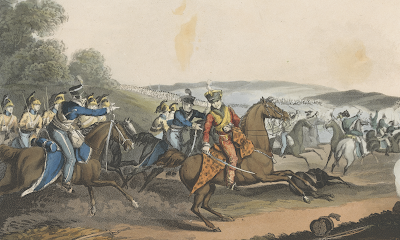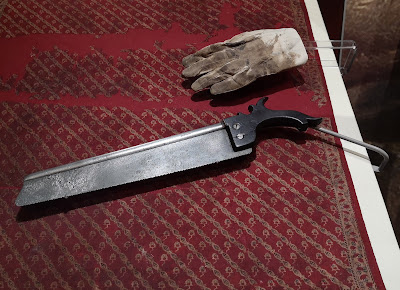Such carnage I never before beheld. The firing of guns etc was so great that the man next to me could not hear my orders.
The Battle of Waterloo from The wars of Wellington, a narrative poem
by Dr Syntax, illustrated by W Heath & JC Stadler (1819)
Captain Joseph Logan, 2nd Battalion 95th Foot, writing from Paris a month after the Battle of Waterloo.1
Captain Logan was one of the thousands of British soldiers on the battlefield that June day in 1815.
Every one of those thousands of soldiers could tell their own tale of British Army life. They’d have stories of how they were recruited, of hours of drill and practice, of travelling to new places and of strict regulations and tough discipline.
You can read more about the Battle of Waterloo here.
Like Captain Logan, many would also have graphic stories from battlefields in India, North and South America, Portugal and Spain and, of course, the rolling Belgian countryside at Waterloo.
The British Army of 1815 had been honed by years of active confrontation and battle, most recently with France, in the Revolutionary and Napoleonic wars.
Infantry, Cavalry, Artillery and More
There were many different types of soldier in the British Army of 1815. Each type performed a different function, both on and off the battlefield.
 |
| Reenactors at Chalke Valley history fair (2013) |
The bulk of the British Army in 1815 were foot soldiers. As such, they walked everywhere - or rather, marched, carrying everything they needed with them.
Rifleman Harris served in the British Army from 1802 to 1814. He recalled:
I am convinced that many of our infantry sank and died under the weight of their knapsacks...Besides my well-filled kit, there was the great-coat rolled on its top, my blanket and camp kettle, my haversack, stuffed full of leather for repairing the men’s shoes, together with a hammer and other tools, ship-biscuit and beef for three days. I also carried my canteen filled with water, my hatchet and rifle, and eighty rounds of ball cartridge in my pouch.2
Harris was no longer with the army in 1815, but he served as part of Wellington’s army in the Peninsula Wars.
Infantrymen were known as ‘red coats’, because of the colour of their jackets. They were armed with a musket and a bayonet. There were two battalions of rifles, which were more accurate than muskets.
 |
| The Marquis of Anglesea wounded whilst leading a charge of heavy cavalry at the close of the Battle of Waterloo Print by M Dubourg after JA Atkinson (1815) |
Captain Charles Edward Radclyffe wrote:
The charge of the heavy cavalry in line was a magnificent sight, and I have every reason to believe they did everything to justify the high expectations their appearance had excited.3
Cavalry were armed with a sabre and a carbine, a light pistol.
 |
| Waterloo battery - bronze 6-pounder gun seized at the Battle of Waterloo - Tower of London (2016) |
The first was the regular cannon, which typically fired either a solid ball or canister shot—smaller pieces of shot designed to damage infantry or cavalry. The cannon usually aimed directly at their target.
Gunner John Edwards of the Royal Horse Artillery wrote:
About half past 10 o’clock the French Imperial Guards dressed in steel armour back and breast plates, they weigh about 32 pounds, charged up the main road till they came within 600 yards they extended right and left of the road, we fired case shot at them and swept them off like a swathe of grass before a scythe.4
The second was the howitzer, a short-barrelled cannon angled upwards. These fired shot into the air, reaching targets behind obstacles.
The third was the Congreve rocket, a relatively new innovation that delivered mixed results. The rockets were easier to deploy and faster to fire than cannon, but they weren’t always the most effective.
Years after Waterloo, Henry Leathes recalled that a rocket launched during the battle opened a gap in the French ranks “probably from the novelty of such a pyrotechnique salute.”5
 |
| Bronze 3-pounder gun, 1815 at National Army Museum, London (2022) |
Supporting roles
Royal Engineers
The Royal Engineers were formed a century before 1815 to provide map-making, bridge building, fortifications and camp drainage systems. They also ran the Army’s postal service.
Initially the Royal Engineers comprised only officers, who would hire civilian labour or use private soldiers to perform the hands-on work of digging and building. However, by 1815 they had their own private soldiers, known as sappers.
Medical services
 |
| Saw used to amputate Lord Uxbridge's leg at the Battle of Waterloo (1815) On display in the National Army Museum, London (2022) |
There was no formal process for getting injured soldiers from the frontline to wherever the medical service was based.
Amputation of damaged limbs was a common procedure, with around 500 probably being performed during the Battle of Waterloo. The most well-known was the removal of Lord Uxbridge’s leg. These and other procedures were performed without anaesthetic.
Deputy Inspector John Hume wrote:
There was but one opinion amongst us, so having prepared the dressings etc, we returned into the room where I announced to Lord Uxbridge that the operation being found necessary the sooner it was performed the better.6
Civilians
A number of non-military personnel, typically women, followed the British Army of 1815. Many of these camp followers were working class wives, widows and mothers who had some form of relationship with soldiers.
A number of wives were permitted to travel with their soldier husbands, both of commissioned and non-commissioned officers.
Other civilians included clerks, cooks and those associated with transport and supply activities.
Organisation of the British Army in 1815
As today, the British Army of 1815 was made up of many different regiments—there were well over 100. Every regiment has its own history, traditions, insignia and colours (flag). The oldest regiments trace their history back to the English Civil War in the mid-1600s
The Coldstream Guards hold the honour of being the oldest continuously serving regiment. It was formed in 1650, ten years before the British Army was founded by Charles II in 1660.
A regiment was made up of battalions, each numbering several hundred men. Some regiments had more than one battalion and these usually operated independently, rarely fighting together.
In 1815 most infantry regiments had been allocated a number and a county designation. The numbering indicated their seniority, or precedence, which was based on when and where they were founded.
This led to regiments having names such as:
- 54th (West Norfolk) Regiment of Foot
- 1st Life Guards
- Coldstream Guards
- Royal Welch Fusiliers
A regiment was led by a colonel.
Ranks in the British Army of 1815
Most men entered the army by enrolling as a private soldier.
Many never progressed beyond the rank of private, but they were often referred to with a designation that represented the branch of the army they were part of, such as Trooper, Gunner, Sapper, Rifleman etc.
A private soldier could be promoted to a non-commissioned officer, such as a corporal or sergeant.
 |
| A captain from A book explaining the ranks and dignitaries of British Society (1809) |
This allowed a man to join up as an officer, despite having no military experience or training. Because the commission had to be paid for, it ensured that most officers came from the upper levels of society.
Some soldiers were promoted from the ranks on merit, but it wasn’t very common.
Listing a hierarchy of ranks in 1815 isn’t as simple as it might appear. There were various forms of rank, and there were exceptions to all of these. It was possible for a specific captain to be senior to a specific major, depending on the positions they were serving in.
Another example would be a colonel given the rank of brigadier general while they were leading a brigade (a force comprising a number of battalions). Once that role was over, they went back to being a colonel.
Outline of ranks in the army
- General
- Lieutenant general
- Major general
- Brigadier general
- Colonel - one per regiment, and not a rank that could be purchased.
- Lieutenant Colonel - between one and three in a regiment.
- Major
- Captain
- Lieutenant
- Ensign/Cornet (Infantry/Cavalry)
- Sergeant
- Corporal
- Private
If you have enjoyed this blog and want to encourage me and help me to keep making my research freely available, please buy me a virtual cup of coffee by clicking the button below.
Notes
- Glover, Gareth (editor), The Waterloo Archive Volume I: British Sources (2010) p157, Captain Joseph Logan.
- Hibbert, Christopher (editor), The Recollections of Rifleman Harris (1970) p13.
- Glover, Gareth (editor), The Waterloo Archive Volume I: British Sources (2010) p23, Captain Charles Edward Radclyffe.
- Glover, Gareth (editor), The Waterloo Archive Volume I: British Sources (2010) p102, Gunner John Edwards, Royal Horse Artillery.
- Glover, Gareth (editor), The Waterloo Archive Volume I: British Sources (2010) p110, Henry Leathes.
- Glover, Gareth (editor), The Waterloo Archive Volume I: British Sources (2010) p215 Deputy Inspector John Hume
Sources used include:
Burnham, Robert and McGuigan, Ron, The Napoleon Series (2016)
Glover, Gareth (editor), The Waterloo Archive Volume I: British Sources (2010)
Hibbert, Christopher (editor), The Recollections of Rifleman Harris (1970)
Simonson, Sheila, Following the drum: British women in the Peninsular War (1981)
Sinclair, Joseph, A Soldier of the Seventy-first (2010)
British Military History website
Military History Matters website
Royal Armouries Collections website
Photographs © RegencyHistory.net



No comments:
Post a Comment